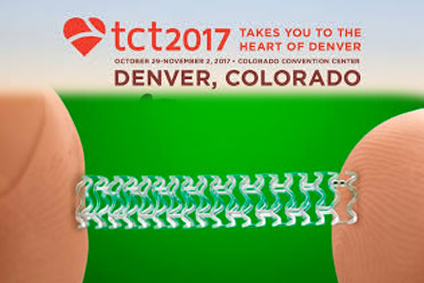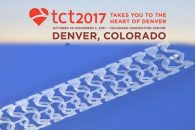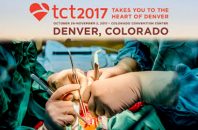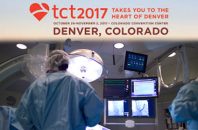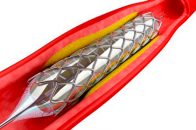Courtesy of the SBHCI. The Absorb IV trial randomized 2604 patients in a 1:1 ratio to receive an Absorb everolimus-eluting bioresorbable scaffold or a Xience stent. With the aim of minimizing the problems observed in previous studies, the Absorb IV protocol excluded small caliber (<2.5 mm) vessels and included mandatory aggressive pre-dilation followed by non-complacent balloon post-dilation. Patients could…
ABSORB II: No Benefits from Scaffolds After Complete Bioresorption
Courtesy of the SBHCI. The ABSORB II study sought to assess the mechanical properties of everolimus-eluting bioresorbable scaffolds, such as the increase in minimal lumen area and the recovery of the vasomotor properties of the treated artery. Last year saw the publishing of negative results for the primary endpoints, registering a higher rate of complications at…
DKCRUSH-V: What Is Simple Is Not Always Best for the Left Main Coronary Artery
Courtesy of the SBHCI. Angioplasty of true distal left main bifurcation lesions with a double-kissing (DK) crush two-stent strategy, compared with provisional stenting, results in lower rates of target lesion failure at 1 year. These findings were largely driven by lower rates of target vessel infarction and definite/probable stent thrombosis. Read also: “EXCEL-QOL Substudy: Similar Quality…
EXCEL-QOL Substudy: Similar Quality of Life both with CABG and Left Main PCI
Courtesy of SBHCI. According to a new quality of life sub-study, the “EXCEL”, both coronary artery bypass graft and left main PCI are associated with significant clinical improvement in terms of angina frequency, tolerance to exertion and treatment satisfaction. At 12 and 36 months, there were no significant differences between PCI and surgery after several quality of…
HREVS: Hybrid Revascularization Offers No Advantage in Multivessel Disease
Courtesy of SBHCI. Hybrid revascularization, which combines CABG with PCI, failed to reduce myocardial ischemia and major cardiac and cerebrovascular events, compared to cardiac artery bypass graft or PCI separately. However, this small study does not provide conclusive evidence, which calls for further randomized studies with enough statistical power to answer this question. Fortunately, we won’t have…
CULPRIT-SHOCK Results Will Transform Guidelines and Clinical Practice
Courtesy of the SBHCI. After treating the culprit lesion in patients with acute myocardial infarction complicated by cardiogenic shock, continuing revascularization of all other lesions worsens outcomes. This finding of the CULPRIT-SHOCK trial has changed entirely the way we treated this patient group and will surely modify guidelines. Culprit-lesion treatment with the option to perform…
DARE: Drug-Coated Balloons Compete with DES for the Treatment of In-Stent Restenosis
Courtesy of the Brazilian Society of Hemodynamics and Interventional Cardiology (SBHCI). The SeQuent Please paclitaxel-coated balloon provides non-inferior angiographic results when compared with the Xience everolimus-eluting stent for the treatment of in-stent restenosis. At 6 months, the minimal lumen diameter was 1.71 mm in the drug-coated balloon arm and 1.74 mm in the Xience arm, a difference that…
Fentanyl in Angioplasty: What Is the Price of More Comfort During the Procedure?
Fentanyl is a potent opiate commonly administered in the cath lab. Recently, questions on its safety have been raised by research demonstrating that intravenous morphine significantly delays the absorption of oral P2Y12 platelet inhibitors. The mechanism might be slowed gastric emptying. The Platelet Aggregation with tiCagrelor Inhibition and FentanYl (PACIFY) trial enrolled 212 patients undergoing indicated…
2.0-mm DES for Very Small Vessels: Are They Viable?
The reference vessel diameter is a fundamental factor for restenosis after coronary angioplasty even with drug-eluting stents. The smallest sized stents available are 2.25 mm in diameter, but even smaller vessels can be symptomatic. This was a prospective multicenter trial of the Resolute Onyx 2.0-mm zotarolimus-eluting stent. The primary endpoint was target lesion failure. Read also: “Effects…
Effects of Cerebral Radiation on Interventional Cardiologists
In recent years, there has been a growing concern about the occupational hazard for interventional cardiologists who have high and unprecedented levels of ionizing radiation exposure. microRNAs are a class of short and highly conserved non-coding RNA molecules (about 22 nucleotides) that become altered (dysregulated) in many diseases. Read also: “Nearly half of interventional cardiologists may…
Excellent Outcomes for the First Sirolimus Eluting Balloon Tested on Instent Restesosis
Much has been done since studies on conventional balloon angioplasty for BMS instent restenosis showed over 40% new revascularization. Drug eluting stents, aimed at improving this problem, have never achieved 0% restenosis, which is why technologies such as paclitaxel coated balloons have been developed, with reasonable efficacy (8% to 10% reinterventions rate for BMS restenosis and 17% to 23%…
